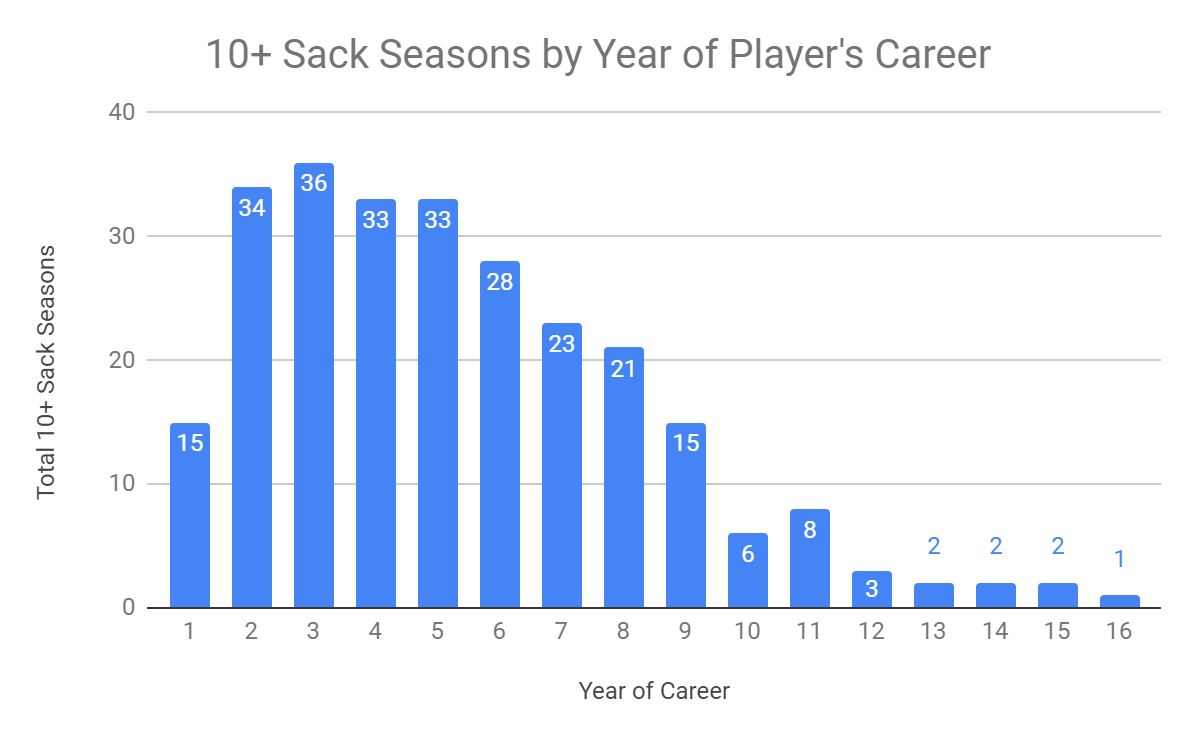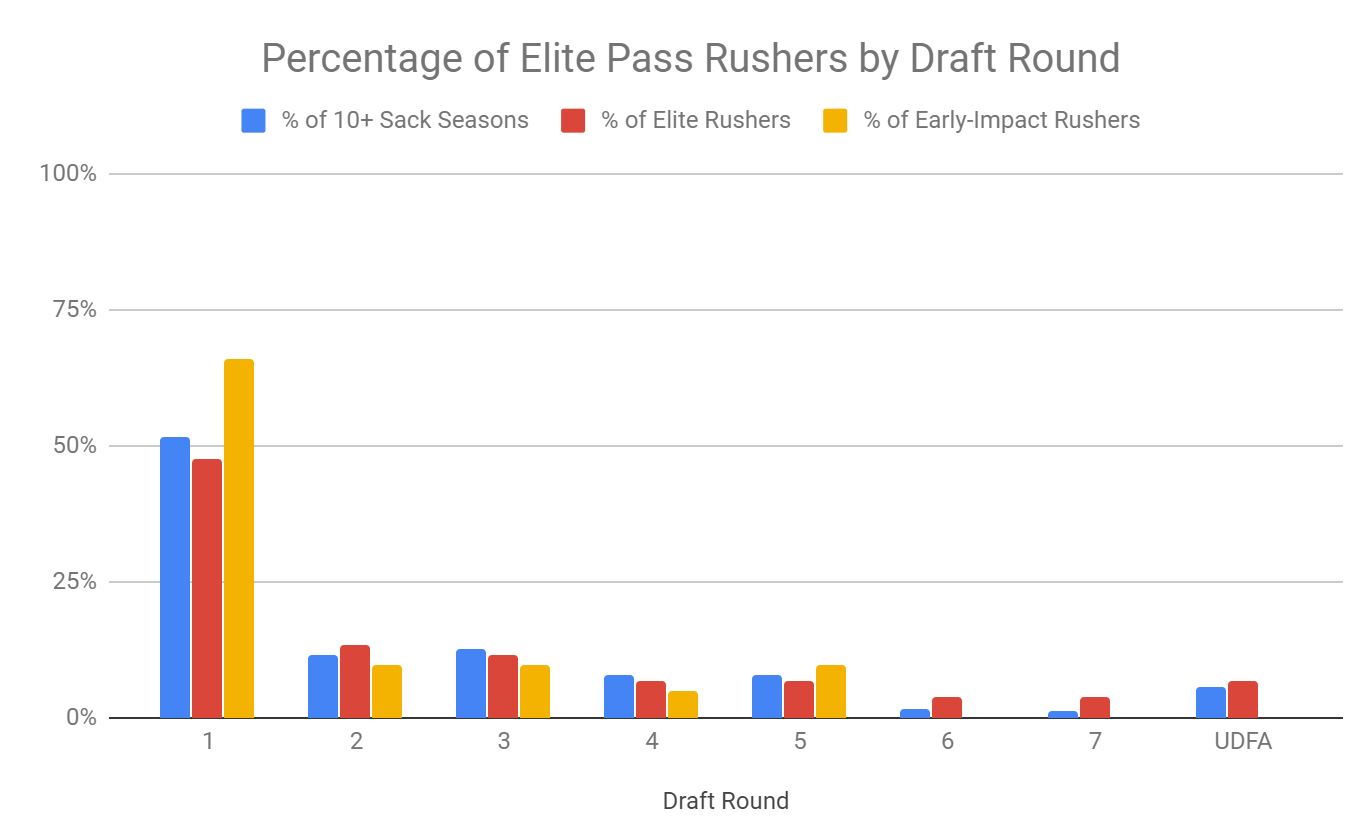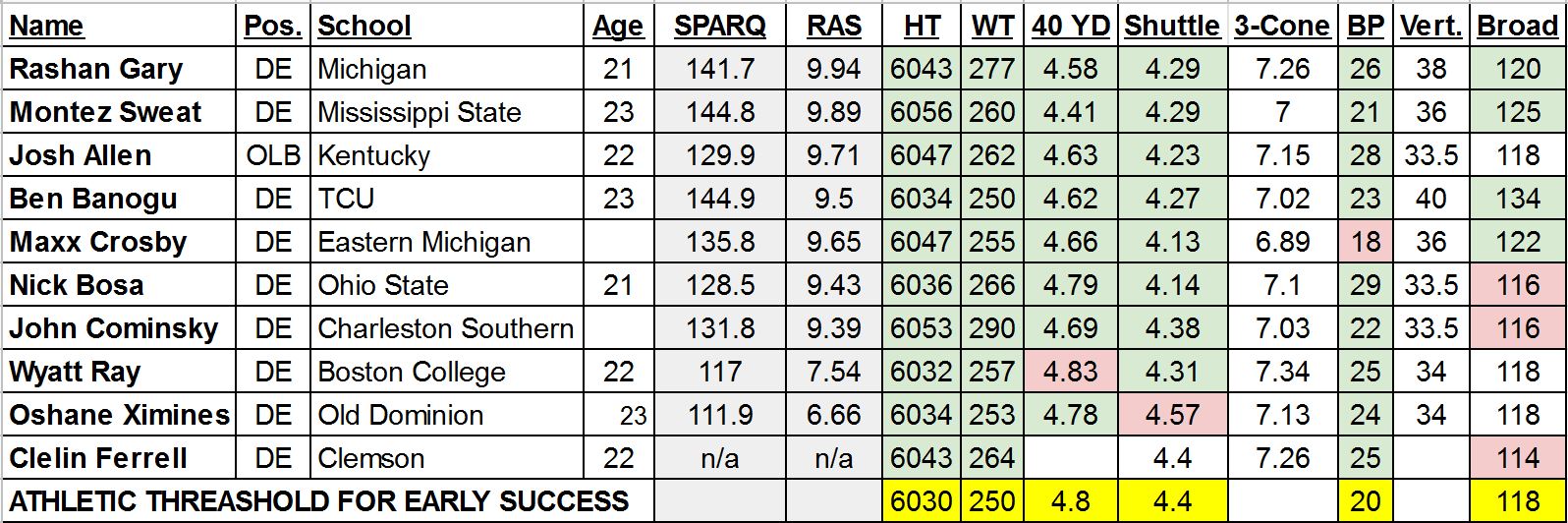With Bud Dupree entering the final year of his contract and no long-term deal in place, the Steelers may consider adding depth to the outside linebacker position in the 2019 Draft. Finding an elite pass rusher is an inexact science. Jarvis Jones was an infamous bust (though not the only one from the historically bad 2013 Draft Class) and Bud Dupree has failed to live up to expectations. On the other hand, TJ Watt produced an elite season with 13 sacks in just his second year. Jones was a highly productive college player but a marginal athlete. After Jones’ failure to produce, the Steelers shifted philosophy into targeting highly athletic pass rushers and selected Dupree and Watt.
10 Sacks is the Magic Number
While projecting success for a pass rushing prospect can be difficult, judging that success is not. One of the statistics that has been the most stable over time in the NFL is the number of players who record 10+ sacks in a season. The double-digit sack threshold is an excellent metric to judge elite pass rushing talent. Over the last 19 years, there has been an average of 17.5 players per season that have recorded 10+ sacks and that number has been relatively consistent over time.
Using 10+ sacks as the metric for determining a successful pass rusher, we can look at those who have had past successes for common trends. Over the last 19 years, there have been 333 total player seasons with 10+ sacks. Those 333 seasons have been recorded by 144 different players. Of those 144 players, only 15 produced a 10+ sack season during their rookie year. Having a rookie pass rusher clear the 10+ sack threshold is a unique event (only Joey Bosa and Bradley Chubb have done it in the last 7 years). However, the most common seasons for a player to record a double-digit sack season are between their 2nd and 5th year in the league.
While only 15 players produced a 10+ sack season in their rookie campaign, 69 players had their first 10+ sack season between their 2nd and 5th seasons. That leaves 21 players drafted since 2000 that produced their first 10+ sack season during their second contract (after their 5th year in the league). Excluding Bradley Chubb (who has only played 1 season and recorded double-digit sacks), 12 of the 14 players who accomplished it as a rookie went on to have at least one more double-digit sack season in their careers. Of the 84 players who had a 10+ sack season within the first 5 years of their career, 37 would have another during their second contract (after Year 5). Finding elite pass rushers is difficult, but the data supports a strategy of retaining players who produce 10+ sack seasons early in their career and cutting bait with those who have not produced an elite campaign during their first 5 years.
Athletic Thresholds for Early Success
Since 2000, there have been 51 double-digit sack seasons recorded by players in either the first or second year of their career. Of the 40 edge rushers that have recorded double-digit sacks in their first two seasons, only 8 entered the league under 250 pounds and only 3 were under 245. From a height perspective, only 7 of the 40 were shorter than 6’3? with only two (Dwight Freeney and Elvis Dumervil) listed below 6’2?. Only 7 of the 40 ran a 40-yard dash slower than 4.8 seconds (with only 2 above 4.9). Other numbers are harder to come by, especially for players that had an injury at the combine and did not participate in all of the drills. But it is worth noting that most players were above a 118-inch broad jump, faster than 4.4 seconds in the 20-yard shuttle, and put up at least 20 reps on the bench press.
Over the last two years, five players have recorded 10+ sacks in either the first or second year of their career. In 2017, Joey Bosa and Yannick Ngakoue reached double-digit sacks and in 2018 Myles Garrett, TJ Watt, and Bradley Chubb joined the club. Of that group of 5 players, all but Ngakoue were over 6’3″ and all but Bosa ran a 40-yard dash faster than 4.8 seconds. All five players weighed in at over 250 pounds. In the second-tier statistics, Ngakoue’s broad jump was exactly 118″ while the rest of the group was over 120″. Garrett did not run a 20-yard shuttle. Bosa (4.21 seconds) and Watt (4.13 seconds) were the only players to complete the drill faster than 4.4 seconds. All five players put up at least 20 reps on the bench press. On the whole, Myles Garrett and TJ Watt met the thresholds in every category while Bosa and Chubb hit on 5 of the 6. Ngakoue was the outlier with just 4 of the 6 athletic thresholds.
Hitting these athletic thresholds is no guarantee of success, but it can be an indicator. In the 2017 Draft Class, TJ Watt, Jordan Willis, and Ifeadi Odenigbo checked all six boxes. Watt broke the 10-sack barrier in his second year while Willis has just 2 career sacks as a backup and Odenigbo was a training camp cut by Minnesota. Myles Garrett who also registered double-digit sacks in his second year checked all of the boxes except the 20-yard shuttle which he did not run. Trey Hendrickson did not participate in the bench press but checked all the other boxes and like Willis has 2 career sacks as mainly a backup. Tarell Basham and Daeshon Hall broke the thresholds in every category except the bench press. Bashham and Hall are also backups. So while Watt and Garrett have been successful, others with similarly strong athletic profiles have not been. That said, the data clearly shows that it is better to gamble on a pass rusher with a high athletic upside than an un-athletic (though possibly highly productive college player).
Where Do They Come From?
Of the 333 double-digit sack seasons that have occurred since 2000, more than half (172, 51.6%) have been recorded by first round picks.Of the 105 players drafted since 2000 that recorded a 10+ sack season, 50 of them (47.6%) were first round picks. The first round remains, by far, the best place to find elite pass rushing talent. Of the 40 EDGE Rushers referenced above that recorded a double-digit sack season within their first two years in the league, 26 of them (65%) were first round picks. On the whole, early-impact pass rushers are overwhelmingly come from the first round. About a quarter of elite pass rushing seasons came from players drafted in the second and third rounds. After that, the data dwindles dramatically. In fact, the same number of UDFAs (7) produced double-digit sack seasons as players drafted in the 4th or 5th rounds (both produced 7). UDFAs and late-round picks historically do not develop into early-impact pass rushers. Players chosen after the 5th round who achieved a 10+ sack season did not do so, on average, until their 6th season.
What Does It Mean For 2019?
With the Combine and Pro Days completed, data on nearly all of the 2019 draft prospects is available. Due to injuries, some prospects did not complete certain drills but the data set is as close to complete as possible. Filtering the edge rusher class by the six attributes mentioned above, four players rise to the top as having the potential to produce a double-digit sack season within the first two years. TCU’s Ben Banogu, Mississippi State’s Montez Sweat, Michigan’s Rashan Gary, and Kentucky’s Josh Allen clear all six of the athletic thresholds. Looking at prospects who check all but one of the boxes, Boston College’s Wyatt Ray just missed on the 40-yard dash with a time of 4.83. Old Dominion’s Oshane Ximines had a 20-yard shuttle time of 4.57, his only mark that fell above the thresholds. Eastern Michigan’s Maxx Crosby only mustered 18 reps on the bench press. Charleston Southern’s John Cominsky and presumed Top 5 pick Nick Bosa both came up 2 inches short on the broad jump. The final player to consider is Clemson’s Clelin Ferrell who was recovering from injury and did not run a 40-yard dash but matched thresholds in every drill he completed except the broad jump where he came up 4 inches short.






1 comment
[…] Internally, the SCB war room was split on Sweat. There was some concern about his schematic fit with the Steelers as some saw him better suited as a 4-3 DE. His pass rushing technique needs some work and he displays an inconsistent effort at times. Additionally, his heart condition was discussed as a potential concern. That said, Sweat is solidly in the second tier of pass rushers available in this draft. Given the Steelers need at the position, his value was worth having on the board for consideration. Furthermore, Sweat checks all of the athleticism boxes to be an early-impact pass rusher. […]